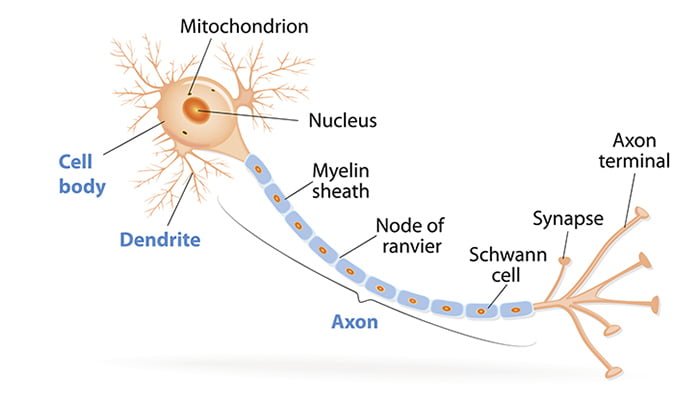What is an axon?
Axons are extremely small neural fibers that transfer nerve impulses from one neuron to another neuron. A neuron is in charge of processing and relaying the electrical signals involved in receiving sensory information, providing motor instructions to your muscles, and controlling movement. Each neuron contains one axon that connects it to other neurons, muscle cells, or glandular cells. Some axons may be quite long, reaching. For example, from the spinal cord down to toe.Vertebrate axons are protected by a myelin coating, which speeds up impulse transmission. It is possible for certain big axons to transfer impulses up to 90 meters (300 feet) per second. The axon is located at the distal end of a neuron and relay output message.
A myelin sheath, a fatty tissue commonly seen on axons which acts as an insulator and significantly increases the conductance of the electrical impulse or message along the axon. An axon can be thinner than the width of the human hair. The length of an axon can range from 1 millimeter in the brain to over 1 meter in the spinal cord.
Functions of Axon
- The axon is a long extension of the nerve cell that carries electrical impulses to the brain.
- An axon is a long, thin projection of a neuron, which usually carries electrical impulses away from the cell body of the neuron.
- Information is transmitted from one neuron to another through the axon.
- Nerve fibers are known as myelinated axons. Information is transmitted through the axon to various neurons, muscles, and glands.
Structure of Axon
Every nerve has axon. The speed at which an axon transmits signals increases with axon diameter. Axons that are generally located inside a myelin sheath are present in the nerve’s innermost region.
Myelin, a fatty protective material, insulates axons and aids in the transmission of impulses across long distances. Myelin is mostly found in neurons that connect different brain regions, rather than in the neurons whose axons remain in the local region.
What is Dendrite?
A neuron’s dendrites are its nerve cell projections that receive signals (information) from other neurons. Electrochemical signals i.e., chemical and electric impulses, are the means by which information is transferred from one neuron to another. The information is typically passed from one neuron to the next starting at the dendrites, moving to the cell body continuing up the neuronal axon as electric impulses, and ending at the synapse, where the two neurons exchange information by chemical signals.
Functions of Dendrite
- Dendrites receive the data or signals from another neuron.
- They collect and store all incoming information from axon terminals.
- Dendrites are the parts of neurons that carry electrical impulses to the nerve cell’s cell body.
- Dendrites receive messages from other neurons or the body’s nerves. These signals are transmitted by the nerve systems to the brain, which then relays them to various sections of the body so that a reaction may take place.
Structure of Dendrite
The cytoplasmic projections of neurons are called dendrites. The central and peripheral nervous systems both contain neurons with a variety of forms and structures.
Similar to the cytoplasm in the cell bodies of neurons, dendritic cytoplasm is made up of the same substances. The cytoskeletal elements that are abundant in it give the dendrites structural support. When neurotransmitters produced at the synapse bind to the membrane of dendrites, the neuron experiences an action potential.

Source: https://www.123rf.com/photo_23684899_anatomy-of-a-typical-human-neuron-axon-synapse-dendrite-mitochondrion-myelin-sheath-node-ranvier-and.html
Learn more about Nerve Impulse Conduction
Difference between Axon and Dendrite
| Parameter | Axon | Dendrite |
| Definition | The term “axon” refers to the long, thread-like component of a nerve cell that transports nerve impulses away from the cell body. | Dendrites are the small branched extensions of nerve cells that transport nerve impulses from synapses to the cell body. |
| Length | Axons are quite lengthy (several meters) 0.25- over10mm | Dendrites are very short strands of tissue (generally below 1.5 mm). |
| Diameter | Diameter of axons is constant. | The diameter of dendrites decreases over time because of their tapering ends. |
| Branching | The terminals of axons are branching. | All of the dendrites are branching. |
| Synaptic knobs | The terminals of the terminal branches of the axon are enlarged to form synaptic knobs. | There are no synaptic knobs at the ends of the branches of the dendrites. |
| Nissl’s Granules | Nissl’s Granules are absent in axons. | Nissl’s Granules are present in dendrite. |
| Neurotransmitters | Axon synaptic knobs contain vesicles containing neurotransmitters. | Neurotransmitter-containing vesicles do not exist in dendrites. |
| Myelin sheath | Can be myelinated or unmyelinated. | Dendrites are myelinated. |
| Nerve impulses / Function | Conducts nerve impulses away from the cell body. | Conducts nerve impulses towards the cell body. |
| Ribosome | No ribosomes. | Have ribosomes, mitochondria. |
| Number | Generally, one axon per neuron. | Usually, many dendrites per neuron. |
Similarities between Axon and Dendrites
- Both are the components of neuron
- Both are branched structures
- Both arises from cell body
- Both transmit nerve impulses as electrochemical signals
References
- https://www.verywellhealth.com/what-is-an-axon-5190652
- https://www.britannica.com/science/axon
- https://qbi.uq.edu.au/brain/brain-anatomy/axons-cable-transmission-neurons
- https://byjus.com/biology/difference-between-axon-and-dendrite
- https://study.com/learn/lesson/what-is-an-axon-terminal-function-types.html
- https://byjus.com/question-answer/function-of-dendrites-and-axon/
- https://biologydictionary.net/dendrite
- https://unacademy.com/content/neet-ug/study-material/biology/difference-between-axon-and-dendrite/